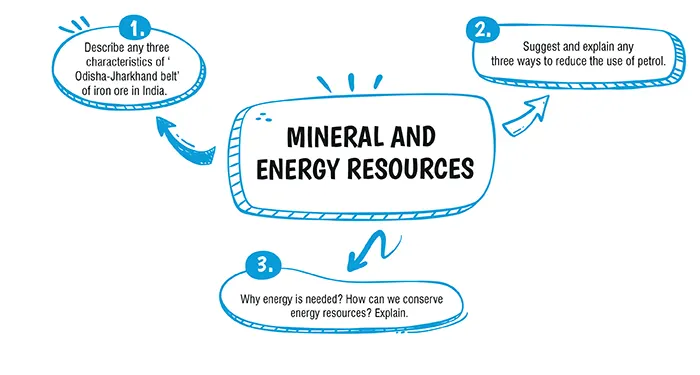Home / Boards / CBSE / Important Questions / Class 10 / Social Science / Mineral and Energy Resources
Table of Contents

Ans. (b)
Explanation:
Kaiga Generating Station is a nuclear power generating station situated at Kaiga, near the river Kali, in Uttara Kannada district of Karnataka, India.
Ans. (d)
Explanation:
The Rajasthan Atomic Power Station (RAPS; also Rajasthan Atomic Power Project - RAPP) is located at Rawatbhata in the state of Rajasthan, India.
Explanation:
The Odisha-Jharkhand Belt has the following characteristics :
(i) Odisha is rich in hematite ore of high grade.
(ii) Hematite ore is found in the Badampahar mines, which are located in the Mayurbhanj and Kendujhar districts.
(iii) Hematite iron ore is also found in the Gua and Noamundi mines, which are located in the Singhbhum district of Jharkhand.
Explanation:
The three ways to reduce the use of petrol are given below :
(i) Switching to alternative sources such as solar energy in the forms of solar heater, solar cookers, use of natural gas and wind energy are some ways to reduce their usage. We can also reduce the use of these natural resources by using public transport and carpool.
(ii) Preference of alternative resources should be given for using renewable natural resources such as the sun and the wind. Windmills use wind energy to produce electricity. The solar energy is used to heat water, cook food and to generate electricity.
(iii) Environmental education plays an important role in creating awareness. Through environmental education, people come to know about their rights and duties towards nature.
Explanation:
Energy is needed for the generation of power that aids in industrial production by the combustion of fossil fuels. Energy is always required as a fuel for vehicles.
We should take the following steps to conserve non-renewable resources :
Prohibiting wastage of resources : Wastage of resources should be reduced. Switching off fans, lights and electronic appliances when not in use, using cooking gas economically, use of pressure cookers, using tube lights in place of electric bulbs are some ways of conserving non-renewable resources which could help in a big way.
Use of substitutes : Alternative sources of energy like solar energy, wind energy, tidal energy, energy from biomass (biogas), etc., can be used on a large scale as a substitute of fossil fuels. For example; use of solar cookers for domestic uses.
Recycling resources : All types of metal wastes, glass, paper and plastic can be recycled and used again. For example; Recycling of paper helps to conserve forests.
| Chapter No. | Chapter Name |
|---|---|
| History | |
| Chapter 1 | The Rise of Nationalism in Europe |
| Chapter 2 | Nationalism in India |
| Chapter 3 | The Making of a Global World |
| Chapter 4 | The Age of Industrialization |
| Chapter 5 | Print Culture and the Modern World |
| Geography | |
| Chapter 6 | Resources and Development |
| Chapter 7 | Forest and Wildlife Resources |
| Chapter 8 | Water Resources |
| Chapter 9 | Agriculture |
| Chapter 10 | Minerals and Energy Resources |
| Chapter 11 | Manufacturing Industries |
| Political Science | |
| Chapter 12 | Power – sharing |
| Chapter 13 | Federalism |
| Chapter 14 | Gender, Religion and Caste |
| Chapter 15 | Political Parties |
| Chapter 16 | Outcomes of Democracy |
| Economics | |
| Chapter 17 | Development |
| Chapter 18 | Sectors of the Indian Economy |
| Chapter 19 | Money and Credit |
| Chapter 20 | Globalization and The Indian Economy |
| Chapter Wise Important Questions for CBSE Board Class 10 Geography |
|---|
| Resources and Development |
| Forest and Wildlife Resources |
| Water Resources |
| Agriculture |
| Minerals and Energy Resources |
| Manufacturing Industries |
CBSE Important Questions Class 10
ICSE Important Questions Class 10
CBSE Important Questions Class 10
ICSE Important Questions Class 10